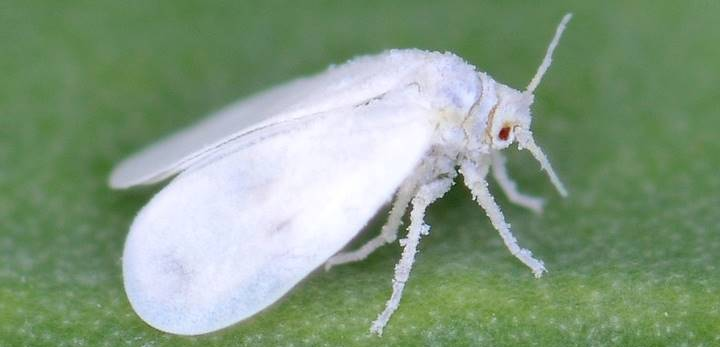Important Facts For Prelims
White Fly
- 27 Sep 2022
- 4 min read
Why in News?
Recently, there has been a rise in the number of white fly attacks on cotton in various states like Punjab and Rajasthan.
What do we Know about White Fly?
- About:
- Whitefly is a serious pest of cotton that lowers yield by feeding on the underside of the leaf and spreading diseases like Cotton Leaf Curl Virus.
- They feed on the sap of the leaves and release fluid onto the leaves on which a black fungus grows, this affects photosynthesis, the food-making process of the plant, and so lowers the strength of the plant.
- Spread:
- The first reported invasive spiralling whitefly (Aleurodicus dispersus) is now distributed throughout India.
- Similarly, the rugose spiralling whitefly (Aleurodicus rugioperculatus) which was reported in Pollachi, Tamil Nadu in 2016 has now spread throughout the country.
- Aleurodicus dispersus and Aleurodicus rugioperculatus have been reported on over 320 and 40 plant species, respectively.
- Most of the whitefly species are native to the Caribbean islands or Central America.
- Reasons for Spread:
- The host range of all of the invasive whiteflies has been increasing due to their polyphagous nature (ability to feed on various kinds of food) and prolific breeding (produces a large number offsprings).
- The increasing import of plants and increasing globalization and movement of people have aided the spread of different varieties and their subsequent growth into invasive species.
- Concerns:
- Damage to Crops:
- Whiteflies reduce the production yield and also damage crops. Approximately 1.35 lakh hectares of coconut and oil palm in India are affected by the rugose spiralling whitefly.
- Other invasive whiteflies were also found to expand their host range on valuable plant species, especially coconut, banana, mango, sapota, guava, cashew, oil palm, and ornamental plants such as bottle palm, false bird of paradise, butterfly palm and important medicinal plants.
- Ineffectiveness of Insecticides:
- Whiteflies have been difficult to control by using available synthetic insecticides.
- Damage to Crops:
- Controlling Whiteflies:
- They are currently being controlled by naturally occurring insect predators, parasitoids (natural enemies of pests, provide biological control of pests in greenhouses and crop fields) and entomopathogenic fungi (fungi that can kill insects).
What are other Pests/Insects Attacking Crops?
- Fall Armyworm (FAW) Attack:
- It is a dangerous transboundary insect with a high potential to spread rapidly due to its natural distribution capacity and opportunities presented by international trade.
- In 2020, the Directorate of Agriculture reported an armyworm attack on the standing crops in the northeastern Dhemaji district of Assam.
- Locust Invasion:
- A locust (Migratory insect also known as tiddi) is a large, mainly tropical grasshopper with strong powers of flight. They differ from ordinary grasshoppers in their ability to change behaviour (gregarize) and form swarms that can migrate over large distances.
- Locust adults can eat their own weight every day, i.e. about two grams of fresh vegetation per day. A very small swarm eats as much in one day as about 35,000 people, posing a devastating threat to crops and food security.
- Pink Bollworm (PBW):
- It (Pectinophora gossypiella), is an insect known for being a pest in cotton farming.
- The pink bollworm is native to Asia but has become an invasive species in most of the world’s cotton-growing regions.








